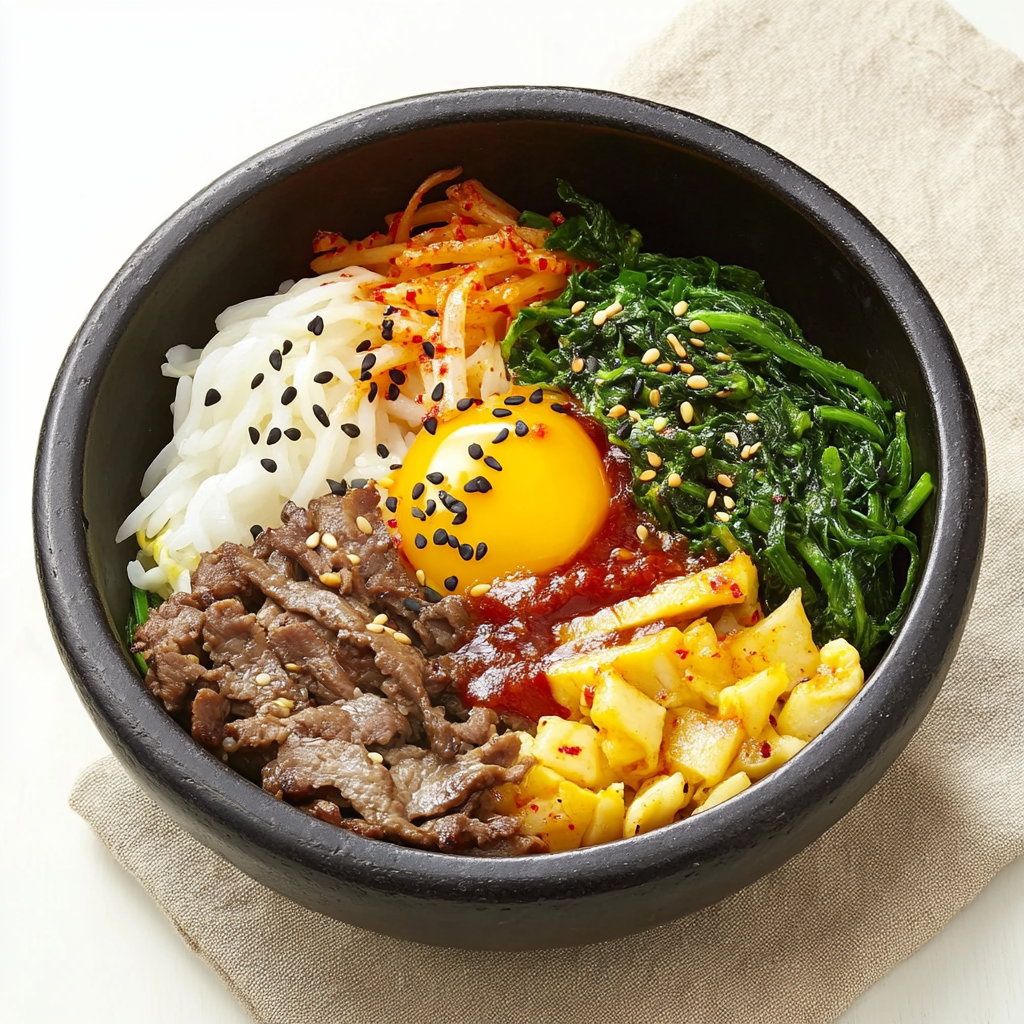Bibimbap is a flavorful and nutritious Korean rice bowl dish that combines a balance of proteins, vegetables, and grains. It is an easy way to incorporate a variety of fresh ingredients into a single meal. The combination of vibrant vegetables, lean protein, and spicy gochujang offers a delightful mix of flavors and textures. This dish is not only delicious but also rich in essential nutrients, making it a wholesome option for lunch or dinner.
Essential Ingredients
To prepare bibimbap, you will need the following key ingredients:
- English Cucumber: Adds a fresh and crunchy texture.
- Gochujang (Korean hot pepper paste): Provides a spicy and savory kick (optional for those who prefer milder flavors).
- Fresh Spinach: A nutrient-rich green that contributes to the dish’s vibrancy.
- Soy Sauce: Enhances the umami flavor.
- Olive Oil: Used for cooking the vegetables and beef.
- Carrots: Brings sweetness and color.
- Garlic: Adds aromatic depth.
- Red Pepper Flakes: Enhances the spice level.
- Thinly-Sliced Beef Top Round Steak: Provides a hearty and protein-rich element.
- Eggs: A fried egg adds creaminess and richness.
- Cooked White Rice: The base of the dish.
- Toasted Sesame Oil: Infuses a nutty aroma and flavor.
- Sesame Seeds: Adds a subtle crunch.
Preparation Steps
- Prepare the Cucumber: Stir the cucumber slices with gochujang in a bowl and set aside.
- Cook the Spinach: Boil water in a skillet and cook spinach until wilted. Drain and mix with soy sauce.
- Sauté the Carrots: Heat olive oil in a skillet, cook carrots until softened, then add garlic and red pepper flakes. Stir in the cucumber mixture.
- Cook the Beef: Brown the beef in a clean skillet over medium heat.
- Fry the Eggs: In a separate skillet, fry eggs on one side until the yolks remain runny but whites are firm.
- Assemble the Bowls: Divide the cooked rice into four bowls. Arrange the spinach, beef, and cucumber mixture on top.
- Add the Finishing Touches: Place a fried egg on each bowl, drizzle with sesame oil, and sprinkle with sesame seeds. Add gochujang as desired.

Health Benefits
Bibimbap is packed with health benefits:
- Rich in Vitamins and Minerals: Spinach, carrots, and cucumbers provide essential nutrients like vitamin C, potassium, and iron.
- High in Protein: The beef and eggs contribute to muscle growth and maintenance.
- Balanced Carbohydrates: White rice offers energy while keeping the dish filling.
- Healthy Fats: Sesame oil and olive oil add beneficial fats for heart health.
Serving Suggestions
- Serve bibimbap hot for the best flavor and texture.
- Mix the ingredients together before eating to evenly distribute the flavors.
- Pair with a side of kimchi for an authentic Korean experience.
- Enjoy with a bowl of miso soup or a light green salad for a well-rounded meal.
Creative Variations
- Vegetarian Bibimbap: Replace beef with tofu or mushrooms for a plant-based alternative.
- Brown Rice Bibimbap: Use brown rice instead of white rice for added fiber and nutrients.
- Seafood Bibimbap: Add shrimp or salmon for a seafood twist.
- Extra Spicy Version: Increase the amount of gochujang and red pepper flakes.
Storage Tips
- Store leftovers in an airtight container in the refrigerator for up to 2 days.
- Keep the egg separate and fry fresh before serving.
- Reheat in a skillet for best results, or use a microwave for convenience.
Pro Tips
- Use a stone bowl (dolsot) for a crispy rice texture.
- Marinate the beef ahead of time for enhanced flavor.
- Adjust spice levels by adding more or less gochujang.
- Add a drizzle of soy sauce if the dish needs extra seasoning.
Frequently Asked Questions
Can I make bibimbap ahead of time?
Yes, you can prepare the components in advance and assemble them just before serving.
What can I use instead of gochujang?
You can substitute gochujang with Sriracha or a mix of soy sauce and a pinch of sugar.
Is bibimbap gluten-free?
To make bibimbap gluten-free, use tamari instead of soy sauce and ensure that the gochujang you use does not contain gluten.
Can I use other vegetables?
Absolutely! Bell peppers, zucchini, or bean sprouts make great additions.
How do I make bibimbap spicier?
Add more gochujang or red pepper flakes according to your spice preference.
Enjoy your homemade bibimbap, a delicious and nourishing Korean rice bowl!

Leave a Comment